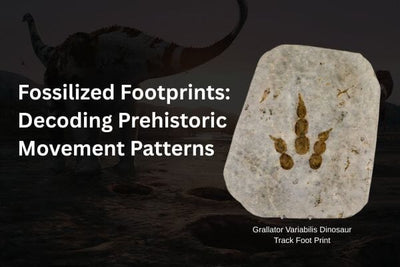Footprints made by animals in the mud or sand a very long time ago became trace fossils. These marks show how ancient creatures moved. In some ways, the tracks show more than bones do. These fossil tracks can tell us how fast the animals could go. They can also show what the animals did and how they moved together in groups.
What Are Trace Fossils and How Do Footprints Form
Trace fossils, or ichnofossils, are signs left by animals or other living things. The fossils show what they did, not their bodies. Some of these marks are footprints, burrows, trackways, and places where they fed.
Footprints happen when an animal steps on the wet or soft Earth. The weight of its body pushes down, leaving a mark in the ground.
-
The toes push and move sediment, making a real track.
-
Pressure goes deeper, making small marks in the lower layers.
-
The print is soon covered by new sediment and hardens over time.
For a footprint to turn into a fossil, things must line up just right. The soil has to be soft so it can take the mark. At the same time, it needs to be firm to keep its shape. The print also has to be buried fast, or else wind and water will wash it away. After that, this mark hardens in stone and remains as a memory of how something moved long ago.
What Footprints Tell Us About Behavior and Movement
Footprints show more than just that something was there. They give us clues about how animals and people moved and acted on the Earth.
-
Stride length and track spacing give clues about how the animal walked and how fast it moved.
-
Trackway direction can indicate whether the animal was walking with a group, following food, or making a trip.
-
Depth and pressure marks tell us if the animal was standing still, moving slowly, or running quickly.
-
Multiple overlapping prints often tell a story of animals chasing each other, avoiding danger, or moving together in a large group.
Because footprints show movement right away, they can reveal actions more clearly than bones.
How Scientists Study Fossilized Footprints
Studying fossil footprints can feel like figuring out a puzzle from the past. Each mark or gap gives us clues to what happened there. Scientists use new tools and years of experience with rocks to read these old tracks correctly. These tracks can be easy to damaged, so they need to be handled with care.
Paleontologists use laser scanning and 3D photogrammetry to make digital models of footprints without hurting them. The models show small changes in pressure. These changes help us see how an animal's weight was distributed. This helps guess the animal’s mass or the way it walked.
Next, looking at what remains in the ground can help us understand the environment where the footprint was made. It helps us see if it was on a dry floodplain, a muddy shore, or on top of volcanic ash. By checking the grain size and how layers sit on each other, we get a better idea of how the footprint stayed in the ground and what kind of surface it was made on.
By studying trackway sequences, researchers can find stride, direction, and sometimes group behavior.
For example, tracks that go side by side and are about the same size usually show many animals moved together, like a herd or pack. A single, deep mark might be from a single animal hunting alone.
Recent studies use biomechanical modeling to copy how ancient animals moved. They take dinosaur footprints and compare them to how reptiles and birds move today. By doing this, people turn fossilized footprints into guides that show how ancient life moved.
Challenges in Interpretation
Footprints can provide valuable information, but they are not easy to read.
-
Many animals leave tracks that look the same, so it can be hard to know which one made them.
-
Water, wind, or rock pressure can change the tracks’ shape over time.
-
Soft parts like paws or nails can change how the track looks, and sometimes parts of the track may be missing.
-
Pressure from the land can push or bend the place where the track is.
To address this, the scientists look at footprints and body fossils. They also study sediment layers and environmental signs. This helps them get good ideas about how animals lived and how they behaved.
How Footprints Tie Into Fossil Collections
While Fossil Age Minerals is known for body fossils like bones, teeth, ammonites, and sea specimens, learning about trace fossils can help people value these items even more. Fossil footprints show how the animals moved, hunted, or ran away in their time. For collectors, knowing this makes each fossil feel like it is part of a history, not just a thing to own.
Bringing Prehistoric Movement to Life
Footprints are among the clearest signs in the study of ancient life. They let us see not just what sort of living things were here before, but also how they walked and interacted with others. When we look at footprints with bones or other fossil finds, we see more of how things used to be. They help us feel closer to that time, one step at a time.
Discover Prehistoric Stories with Fossil Age Minerals
At Fossil Age Minerals, people who collect and love fossils can see real fossils that help them feel close to how Earth used to change. Each item—from old bones to sea fossils—shows a part of the Earth’s story. You can find, read about, and start a set that is about more than old animals, but also how they moved around during their time.


